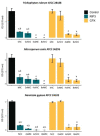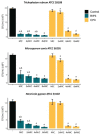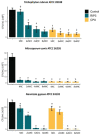Antifungal and Antibiofilm Activity of Riparin III against Dermatophytes
- PMID: 36836345
- PMCID: PMC9966229
- DOI: 10.3390/jof9020231
Antifungal and Antibiofilm Activity of Riparin III against Dermatophytes
Abstract
The ability of dermatophytes to develop biofilms is possibly involved in therapeutic failure because biofilms impair drug effectiveness in the infected tissues. Research to find new drugs with antibiofilm activity against dermatophytes is crucial. In this way, riparins, a class of alkaloids that contain an amide group, are promising antifungal compounds. In this study, we evaluated the antifungal and antibiofilm activity of riparin III (RIP3) against Trichophyton rubrum, Microsporum canis, and Nannizzia gypsea strains. We used ciclopirox (CPX) as a positive control. The effects of RIP3 on fungal growth were evaluated by the microdilution technique. The quantification of the biofilm biomass in vitro was assessed by crystal violet, and the biofilm viability was assessed by quantifying the CFU number. The ex vivo model was performed on human nail fragments, which were evaluated by visualization under light microscopy and by quantifying the CFU number (viability). Finally, we evaluated whether RIP3 inhibits sulfite production in T. rubrum. RIP3 inhibited the growth of T. rubrum and M. canis from 128 mg/L and N. gypsea from 256 mg/L. The results showed that RIP3 is a fungicide. Regarding antibiofilm activity, RIP3 inhibited biofilm formation and viability in vitro and ex vivo. Moreover, RIP3 inhibited the secretion of sulfite significantly and was more potent than CPX. In conclusion, the results indicate that RIP3 is a promising antifungal agent against biofilms of dermatophytes and might inhibit sulfite secretion, one relevant virulence factor.
Keywords: alkamides; antifungal; dermatophytes; ex vivo; fungicide; riparin; sulfites.
Conflict of interest statement
The authors declare no conflict of interest.
Figures




Similar articles
-
Riparin II-type benzamides as novel antibiofilm agents against dermatophytes: chemical synthesis, in vitro, ex vivo and in silico evaluation.J Antimicrob Chemother. 2024 Mar 1;79(3):617-631. doi: 10.1093/jac/dkae013. J Antimicrob Chemother. 2024. PMID: 38297992
-
In vitro and ex vivo antibiofilm activity of riparin 1, and its nor and dinor homologs, against dermatophytes.Mycologia. 2023 Mar-Apr;115(2):206-215. doi: 10.1080/00275514.2023.2170209. Epub 2023 Feb 27. Mycologia. 2023. PMID: 36848618
-
A review of recent research on antifungal agents against dermatophyte biofilms.Med Mycol. 2021 Apr 6;59(4):313-326. doi: 10.1093/mmy/myaa114. Med Mycol. 2021. PMID: 33418566 Review.
-
A new acridone with antifungal properties against Candida spp. and dermatophytes, and antibiofilm activity against C. albicans.J Appl Microbiol. 2019 Nov;127(5):1362-1372. doi: 10.1111/jam.14381. Epub 2019 Aug 14. J Appl Microbiol. 2019. PMID: 31297951
-
How to: perform antifungal susceptibility testing of microconidia-forming dermatophytes following the new reference EUCAST method E.Def 11.0, exemplified by Trichophyton.Clin Microbiol Infect. 2021 Jan;27(1):55-60. doi: 10.1016/j.cmi.2020.08.042. Epub 2020 Sep 8. Clin Microbiol Infect. 2021. PMID: 32916260 Review.
Cited by
-
Study on the chemical composition and anti-fungi activities of anthraquinones and its glycosides from Rumex japonicus Houtt.J Nat Med. 2024 Sep;78(4):929-951. doi: 10.1007/s11418-024-01834-x. Epub 2024 Aug 5. J Nat Med. 2024. PMID: 39103726
References
-
- Gnat S., Nowakiewicz A., Zięba P. Taxonomy of Dermatophytes—The Classification Systems May Change but the Identification Problems Remain the Same. Postępy Mikrobiol.—Adv. Microbiol. 2019;58:49–58. doi: 10.21307/PM-2019.58.1.049. - DOI
-
- Rouzaud C., Lanternier F., Puel A. Primary Immunodeficiencies and Dermatophytosis. In: Springer C., editor. Immunogenetics of Fungal Diseases. Springer International Publishing; Berlin/Heidelberg, Germany: 2017. pp. 121–133.
LinkOut - more resources
Full Text Sources
Miscellaneous

